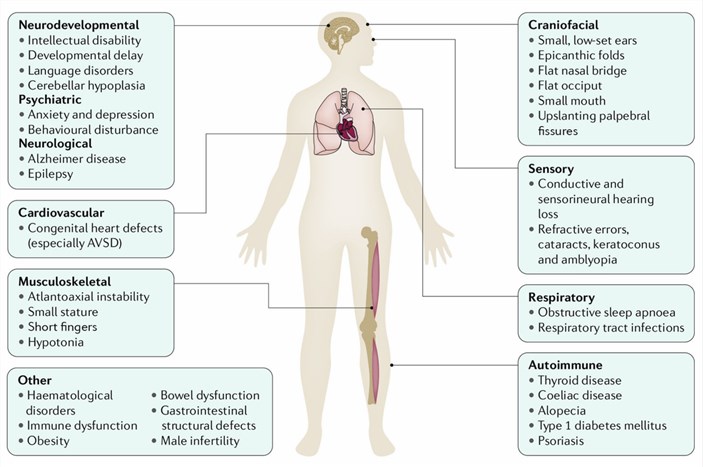Down Syndrome
Down syndrome is a genetic disorder that arises when a person has an extra copy of chromosome 21, resulting in 47 chromosomes instead of the normal 46. This chromosomal abnormality can cause various physical and mental developmental problems, including intellectual disability, distinctive facial features, heart defects, and an increased risk of certain diseases. Down syndrome ranks among the most common genetic disorders, affecting approximately 1 in every 700 live births. The likelihood of having a child with Down syndrome increases with maternal age, especially after 35 years old. Most cases of Down syndrome are not inherited but result from random errors during cell division in the early stages of fetal development. However, some cases are inherited from a parent who carries a balanced translocation, a rearrangement of genetic material between chromosome 21 and another chromosome. The molecular mechanisms underlying the phenotypic features of Down syndrome are not fully understood, but they likely involve the overexpression or imbalance of genes on chromosome 21 and their interactions with other genes.
Clinical Manifestations of Down syndrome
Individuals with Down syndrome exhibit distinctive physical characteristics that can vary in severity and expression. Common features include slanted eyes, a flat nose, small ears, a protruding tongue, short stature, poor muscle tone, and a single palmar crease. Additionally, people with Down syndrome experience various health problems that require medical attention and intervention. These may include congenital heart defects, immune deficiency, respiratory infections, hearing loss, vision problems, thyroid dysfunction, and gastrointestinal disorders. Furthermore, individuals with Down syndrome have an increased risk of developing certain diseases later in life, such as leukemia, Alzheimer's disease, diabetes, and obesity. The clinical manifestations of Down syndrome are influenced by both genetic and environmental factors and can vary widely among individuals.
 Fig.1 Symptoms and manifestations in Down syndrome. (Antonarakis SE, 2020)
Fig.1 Symptoms and manifestations in Down syndrome. (Antonarakis SE, 2020)
Clinical Diagnosis and Treatment Methods of Down syndrome
Down syndrome can be diagnosed before or after birth using different methods. Prenatal screening tests can estimate the likelihood of having a child with Down syndrome based on maternal age, blood markers, and ultrasound findings. Prenatal diagnostic tests can confirm the presence of an extra chromosome 21 in fetal cells through invasive procedures such as amniocentesis or chorionic villus sampling. Postnatal diagnosis is based on the physical features of the newborn and chromosomal analysis using a blood sample. A timely diagnosis of Down syndrome is crucial for providing appropriate medical care and support to affected individuals and their families.
Treatment for Down syndrome aims to enhance the quality of life and prevent or manage associated health problems. Available options include medication, surgery, rehabilitation, and education. While there is no cure for Down syndrome, gene therapy holds promise as a potential approach to correct or modify the genetic defect in the future. Gene therapy involves introducing a normal or modified gene into the cells of a person with a genetic disorder to restore or enhance their function. However, gene therapy for Down syndrome faces numerous challenges, such as safety, efficiency, specificity, and ethical issues.
Conclusion
Down syndrome is an irreversible genetic disorder characterized by chromosomal abnormalities, intellectual disability, distinctive facial features, and various health problems. Diagnosis is based on prenatal screening, prenatal diagnostic tests, and postnatal chromosomal analysis. Treatment focuses on improving the quality of life and managing associated health issues. Timely diagnosis and comprehensive treatment are essential for individuals with Down syndrome. Providing care and support for people with Down syndrome and their families is paramount. Although the future of gene therapy for Down syndrome is promising, it presents significant challenges that need to be addressed.
References
- Antonarakis SE, et al. Down syndrome. Nat Rev Dis Primers. 2020 Feb 6;6(1):9.
- Bittles AH, et al. The influence of intellectual disability on life expectancy. J Gerontol A Biol Sci Med Sci. 2002 Jul;57(7):M470-2.
- Coppedè F, et al. The role of epigenetics in Down syndrome. Neuroepigenetics. 2016 Jan;5:8-15.
- de Graaf G, et al. Estimates of the live births, natural losses, and elective terminations with Down syndrome in the United States. Am J Med Genet A. 2015 Apr;167A(4):756-67.
- Dierssen M, et al. Down syndrome: the brain in trisomic mode. Nat Rev Neurosci. 2012 Dec;13(12):844-58.
- Gardiner KJ, et al. Molecular basis of pharmacotherapies for cognition in Down syndrome. Trends Pharmacol Sci. 2010 Feb;31(2):66-73.
- Head E, et al. Aging in Down syndrome and the development of Alzheimer’s disease neuropathology. Curr Alzheimer Res. 2017 Jan;14(1):40-53.
- Lyle R, et al. Genotype–phenotype correlations in Down syndrome identified by array CGH in 30 cases of partial trisomy and partial monosomy chromosome 21. Eur J Hum Genet. 2009 May;17(5):454-66.
- Nadel L, et al. Memory formation, consolidation and transformation in humans with hippocampal damage and Down syndrome: a review of case studies over the past half century (1967–2017). Learn Mem. 2018 Jun;25(6):235-46.
- Roizen NJ, et al. Medical care of adults with Down syndrome: a clinical guideline [published correction appears in JAMA . 2020 Nov 24;324(20):2116]. JAMA . 2020 Oct 20;324(15):1543-1560.
- Sherman SL, et al. Epidemiology of Down syndrome.Hum Genet . 2007 Oct;121(6):621-37.
